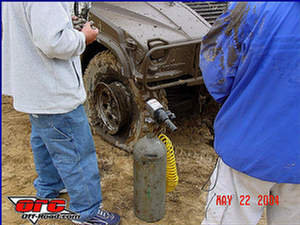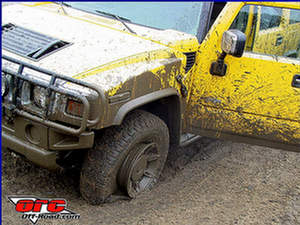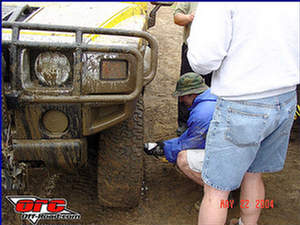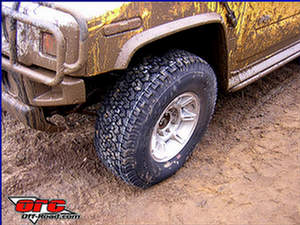|
|
Most wheelers know that there are some significant benefits to lowering tire pressure - particularly in sand, mud, or rocky terrain. A softer tire provides improved flotation, a bigger footprint and a softer ride to name a few. For these reasons, one of the first things a typical wheeler does before venturing onto a trail is deflate the tires to a lower pressure. If that same driver wants to make it home without meandering uncontrollably all over the road and potentially overheating tires to the point of a blowout, those tires will need to be re-inflated before hitting highway speeds. That’s why most Hummers, both H1s and H2s, come from the factory equipped with air compressors. The H1 has the very slick Central Tire Inflation System (CTIS), while the H2 has a compressor in the back that can be used to inflate the tires one at a time. These compressors work fine for inflating tires but they do not generate the pressure and air volume necessary to operate most pneumatic tools.
“On-board air” is a term used to describe a popular modification for a lot of wheelers out there that usually involves modifying an AC compressor to provide compressed air, or installing an additional belt driven or 12v compressor for the primary purpose of re-inflating tires. With the addition of an air tank to accommodate volume demands, these same systems can be used to run air tools as well - which makes field repairs faster and easier.
Given that their trucks are already equipped with systems for inflating tires, installing an on-board air system is overkill for most Hummer owners. So, a good alternative for Hummer owners who want to run pneumatic tools is a liquid CO2 tank setup. Liquid CO2 evaporates at well below room temperature, causing a build up of CO2 gas in the top of the tank, generally in the ballpark of about 800psi. CO2 fire extinguishers use what is called a siphoning tank, with a tube inside that extends from the top valve to the bottom of the tank. The pressure from the gas forces the liquid at the bottom out via the tube, and CO2 liquid comes rushing out when the valve is opened… good for putting out fires, but bad for tools! For air tools, you’ll need a non-siphoning tank, just like the ones used to provide the refreshing bubbles in your favorite beverages at the local bar or restaurant. On these tanks there are no siphon tubes, so as long as you keep the tank upright only gas will escape when you open the valve. Add a CO2 regulator to control the amount of gas you let out at a time along with a hose and some connectors and voila! You now have a high pressure gas source for running your air tools.
If you are driving any model of Hummer without bead-locks, you will probably discover someday that the heavy truck combined with low tire pressure can cause a tire to roll right off the rim. One advantage of a CO2 tank over an on-board air system is that the CO2 can generate bursts of high pressure for the purposes of reseating a tire bead in the field – and this technique is safer than the “spray ether and throw a match” method. I have used my CO2 setup many times to help folks get a truck rolling again after losing a bead, either by just swapping on the spare, or by using the tank in conjunction with a ratchet strap to reseat a bead – or both. To reseat a bead with CO2, jack up the truck until the tire is clear of the ground. Wrap a good 10,000lb ratchet strap around the circumference of the tire, and crank it down until the tire folds a little bit, and the inside of the tire is touching the rim all the way around. Remove the valve stem core, and apply the hose from your CO2 system to the hollow valve stem. Now let the CO2 rip at the highest pressure your regulator will allow. Stand back, and watch as the tire pops back into place on the rim and inflates. If you hear air leaking from somewhere around the rim, push on that side of the tire to close any gaps until the tire starts to inflate and hold air. The ratchet strap will be under heavy load once the tire inflates, so use care when you release it. Sometimes it is easier to just swap on a spare, and then reseat the bead while the tire is off the truck, but either way, having a CO2 tank is going to make the job go faster. By the way, don’t forget to put the valve stem core back in once your tire starts to hold air!
For someone who is only going to use air tools occasionally on the trails, a home built system like mine should do the job just fine. You can buy or rent a tank made specifically for CO2 and get it refilled for around $15 at most local welding or fire supply shops. I rent a 20lb non-siphoning CO2 tank from a local fire equipment shop so that I can just go and swap my empty tank for a full one instead of waiting for it to be filled each time. I also bought a used Tap-Rite 5700 beverage regulator on E-bay for about 20 bucks, and then threaded on a connector for my air hose. If you decide to go with a regulator designed for beverage use, be sure you get something capable of delivering at least 100psi (some have a maximum output pressure of 60psi).
The escaping CO2 gas will cool the regulator and hoses very quickly as it leaves the tank. My regulator will sometimes frost up when used continuously for several minutes to inflate big tires even though it is more than sufficient for the bursts of air needed to run an impact gun or air ratchet at 90psi, or to reseat a bead at 160psi. If you are going to use CO2 to inflate big tires frequently, it would be wise to invest in a high-flow regulator from a company like PowerTank [http://www.powertank.com/] so that you don’t freeze things up and lose flow. You can also choose to buy a complete CO2 tank setup from them. It will cost you more than rigging up your own, but you will also have the peace of mind knowing that you have a professionally assembled system - and a fancy painted or polished tank to boot.
Some guys have been known to bring scuba tanks out on the trail for air tools, because it works and it is cheap - but I wouldn’t recommend it. Unlike liquid filled CO2 tanks with constant gas pressures of around 800psi, a scuba tank is typically filled completely with highly compressed air that starts at pressures in the ballpark of 3000psi, and goes down steadily as you use air. A scuba tank will also run out much more quickly than a CO2 tank, because gas takes up more space than liquid; a large CO2 tank fill will outlast 10 scuba tanks of the same size. Between the safety advantages and the greater capacity, CO2 wins this battle hands down... in my opinion, a full scuba tank on the trail is a bomb or missile waiting to happen. Obviously, CO2 tank setups can save a ton of time on the trail for field repairs, swapping wheels on and off, and speeding up the inflation of a tire here and there. A CO2 tank is safer than a scuba tank, but it is still important to keep in mind that CO2 tanks hold gas at high pressure as well. Always secure the tank well, and take necessary precautions whenever transporting or using the tank. Most tool manufacturers are not going to approve CO2 gas as a power source – so you are using it at your own risk, and don’t expect your tools to be protected under any warranties. Personally, I haven’t had any problems with running my tools on CO2, but your experience may vary. Now get out there and break something so you can
use your tools out in the woods!
|









 Your Privacy Choices
Your Privacy Choices